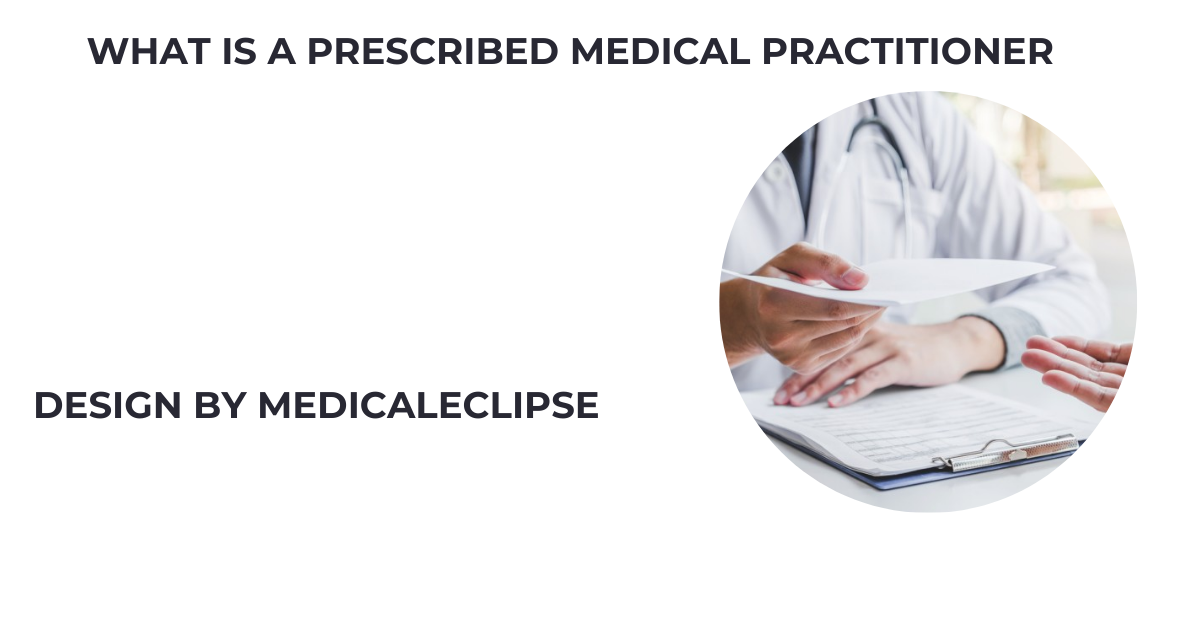A prescribed medical practitioner is a licensed healthcare professional responsible for diagnosing, treating, and managing medical conditions according to established guidelines.
In this article, we will talk about “what a prescribed medical practitioner is, their roles, and why they are important in healthcare.”
Roles and Responsibilities:

A prescribed medical practitioner plays a vital role in the healthcare system. Their responsibilities include:
Here are the detailed roles and responsibilities of a prescribed medical practitioner:
- Diagnosing illnesses and medical conditions – They assess patients’ symptoms, conduct medical tests, and identify diseases or health conditions to provide the right treatment.
- Prescribing medications and treatment plans – Based on their diagnosis, they recommend suitable medicines, therapies, and lifestyle changes to help patients recover or manage chronic conditions.
- Conducting medical examinations and health assessments – They perform routine check-ups, screenings, and physical examinations to detect potential health issues early and ensure overall well-being.
- Monitoring patient progress and adjusting treatments as needed – They track how well a patient is responding to treatment and make necessary adjustments to improve their health outcomes.
- Providing expert medical advice and counseling – They educate patients about their health conditions, treatment options, and preventive care, ensuring they make informed decisions about their health.
- Referring patients to specialists when necessary – If a patient needs advanced or specialized treatment, they connect them with experts in fields like cardiology, neurology, or surgery.
- Ensuring proper healthcare and patient well-being – They follow medical guidelines to deliver safe and effective care, prioritizing patient health and long-term well-being.
Qualifications and Training:
Here is a detailed explanation of the qualifications and training required to become a prescribed medical practitioner:
Complete a medical degree from an accredited institution:
The first step to becoming a prescribed medical practitioner is obtaining a medical degree from a recognized university. This degree, such as an MBBS (Bachelor of Medicine, Bachelor of Surgery) or MD (Doctor of Medicine), provides the foundational knowledge required to diagnose and treat patients. The duration of medical school varies by country but typically takes around 5–6 years.
Undergo specialized training and internships:
After completing medical school, graduates must undergo practical training, usually in the form of an internship or residency program. This hands-on experience allows them to work under the supervision of experienced doctors, applying their theoretical knowledge in real medical settings. Internships usually last 1–2 years and cover various medical specialties, such as internal medicine, surgery, and emergency care.
Also Read: Aqreva Medical Billing Kaiser – Your Partner in Kaiser Billing!
Obtain a valid medical license from a recognized medical board:
To legally practice medicine, a prescribed medical practitioner must pass national or regional licensing exams. These exams assess their medical knowledge, clinical skills, and ethical understanding. Once they pass, they receive a medical license, which allows them to work as a professional healthcare provider. Each country has its own medical licensing authority that regulates this process.
Gain expertise in a specific field through further training (optional):
While some medical practitioners work as general physicians, others choose to specialize in areas such as cardiology, dermatology, neurology, or surgery. Specialization requires additional years of study, training, and exams to become a certified specialist in that field.
Engage in continuous medical education and training:
Medical knowledge and technology are constantly evolving, so prescribed medical practitioners must stay updated with the latest advancements. This is done through attending medical conferences, workshops, and training programs. Many countries require practitioners to complete continuing medical education (CME) credits to maintain their medical licenses.
Follow ethical and legal medical guidelines:

Medical practitioners must adhere to ethical codes of conduct established by medical boards and professional organizations. This includes maintaining patient confidentiality, providing unbiased medical advice, and ensuring treatments are based on scientific evidence. They must also comply with legal regulations related to medical practice in their country.
Develop strong communication and problem-solving skills:
Besides medical knowledge, a prescribed medical practitioner must have excellent communication skills to interact with patients effectively. They must listen carefully, explain medical conditions in simple terms, and provide emotional support when needed. Problem-solving skills are also crucial for diagnosing complex health issues and deciding the best treatment approach.
By completing these steps, a prescribed medical practitioner becomes a qualified and competent healthcare provider, capable of diagnosing, treating, and managing a wide range of medical conditions while ensuring the highest standard of patient care.
Types of Prescribed Medical Practitioners:
There are different types of prescribed medical practitioners, including:
- General Practitioners (GPs): Provide primary care and treat common illnesses.
- Specialists: Focus on specific fields like cardiology, dermatology, or neurology.
- Surgeons: Perform surgical procedures to treat medical conditions.
Also Read: Is Medical Power Of Attorney Same As A Patient Representative – Key Differences Explained!
- Psychiatrists: Specialize in mental health treatment and therapy.
Why Are They Important?
Prescribed medical practitioners ensure proper healthcare delivery, helping individuals maintain their well-being. They provide accurate diagnoses, effective treatments, and essential health advice, improving the overall quality of life.
FAQ’s
1. What does a prescribed medical practitioner do?
A prescribed medical practitioner diagnoses illnesses, prescribes treatments, conducts medical examinations, and provides expert healthcare guidance to patients. They ensure proper medical care and refer patients to specialists when necessary.
2. What qualifications are needed to become a prescribed medical practitioner?
To become a prescribed medical practitioner, one must complete a medical degree from an accredited institution, undergo specialized training and internships, obtain a valid license from a recognized medical board, and continue education to stay updated with medical advancements.
3. Are all doctors considered prescribed medical practitioners?
No, not all doctors are considered prescribed medical practitioners. Only those who meet legal and regulatory requirements set by medical authorities are classified as prescribed medical practitioners.
4. Can a prescribed medical practitioner perform surgeries?
Yes, a prescribed medical practitioner can perform surgeries if they are trained as a surgeon. Otherwise, they refer patients to specialized surgeons for surgical procedures.
5. Why is a prescribed medical practitioner important?
A prescribed medical practitioner is important because they provide essential healthcare services, including diagnosis, treatment, and medical guidance. Their expertise ensures proper patient care, improves overall health, and enhances quality of life.
Conclusion
a prescribed medical practitioner is a licensed healthcare professional who diagnoses illnesses, prescribes treatments, and provides expert medical care. They play a key role in maintaining health by offering accurate diagnoses, effective treatments, and necessary medical advice. Their expertise helps improve overall well-being and ensures patients receive proper care and referrals when needed.

Leave a Reply